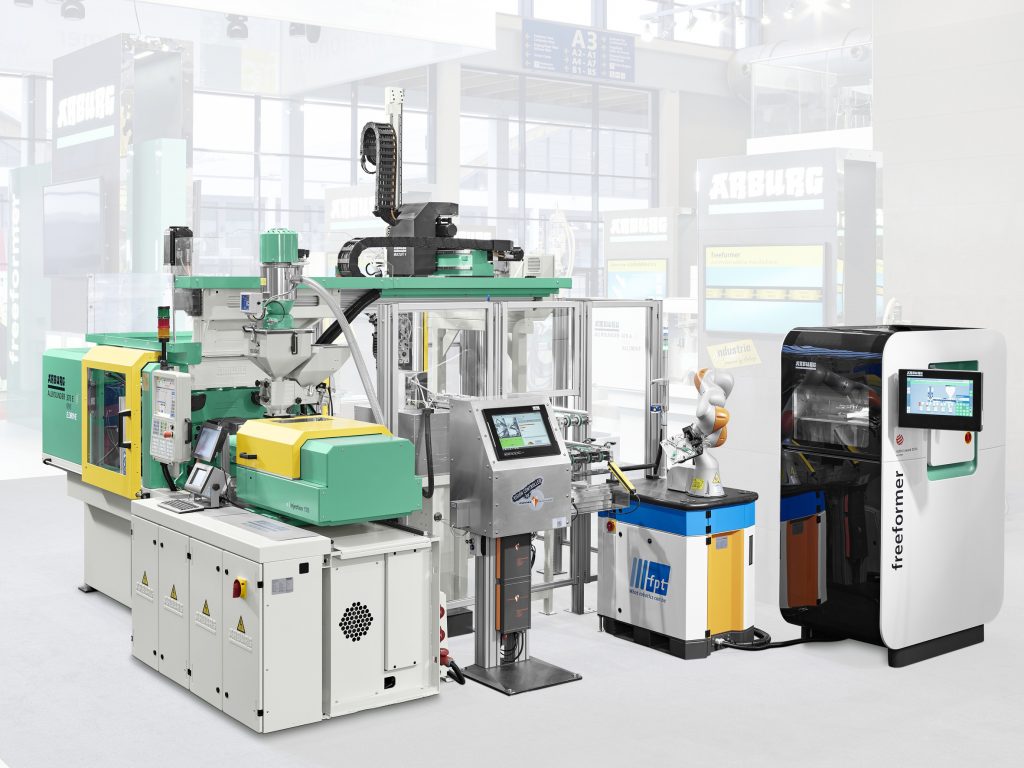3D Printing Industry is taking an in depth look at how additive manufacturing is moving to production. Over the coming weeks the results of interviews with industry leading practitioners will be published.
This article is part of a series examining Trends in Additive Manufacturing for End-Use Production.
Martin Neff is Head of Plastic Freeforming at ARBURG. ARBURG are a German machine manufacturing company, their Freeformer uses ARBURG Plastic Freeforming (APF) to produce functional plastic parts from qualified standard granulate.
3D Printing Industry: What is your percentage estimate of how much your printers are used for production versus other applications?
Martin Neff: 3D printing technology is opening up new options for plastics processing and is already becoming more common in industrial applications. We designed our Freeformer specifically for this purpose. At present, the majority of our customers use the open system mainly for the additive manufacturing of functional prototypes. As well as producing samples, the Freeformer can also quickly manufacture fully functional parts using the original materials at very short notice. Increasing know-how and the option of using qualified standard granulates have meant that the proportion of “genuine” high-volume products made by customers has been growing.
3DPI: Do you have an estimate of the addressable market for AM in production? Which industries / verticals are leading in the use of AM for production?
MN: Individually produced plastic parts for consumer goods, individual medical parts (implants) and small-volume batches, as well as functional spare parts are just three of the many areas for which additive manufacturing is predestined. Moreover, production equipment such as assembly devices and grippers for automation can be produced quickly, flexibly and cost-effectively.
Cost efficiencies can be achieved through the integration of functions through the additive manufacturing of complete component groups in a fully assembled state in a single process step. Where lightweight construction and weight reduction are concerned, bionically optimised parts can be designed and produced, for example, without having to factor in the technical production constraints that apply to injection moulding.

3DPI: What barriers does AM face for production and how are these surmountable?
MN: Additive manufacturing offers enormous design freedom. However, the functional components must achieve the required quality for use in industrial additive high-volume manufacturing on a reproducible basis. This means that the design must meet the requirements of the technology and production process. This calls for a great deal of know-how regarding the machine, material, process and digital model. The functionality of the Freeformer and the basic principles of Arburg Plastic Freeforming are covered in our training courses.
The great design freedom for components offered by additive manufacturing means that design guidelines are also required. These help designers to design their products from the start in such a way that disadvantages with respect to the component structures are avoided in advance and the potential offered by additive manufacturing is fully exploited.

3DPI: Are there any notable trends in AM for end use production?
MN: Requirements are changing in favour of short product life cycles, increasing variant diversity and the desire for individualised products. There is a clear trend in the direction of faster production of high-quality components. When it comes to the production of small-volume batches, additive manufacturing is set to gain further significance thanks to the wider variety of materials and greater cost-effectiveness that it can offer.
3DPI: Can you name any specific case studies where AM is used for end production?
MN: Some of our customers are qualifying their own materials with great success and using them to produce functional parts. For example, igus is using the Freeformer to produce the company’s own lubricant-free, abrasion-resistant materials for corrosion and wear-resistant plain bearings.
At Arburg’s central production location in Lossburg, the Freeformer uses high-temperature plastic polyetherimide (PEI) Ultem 9085 to produces spacers which are installed in Allrounder injection moulding machines. Weighing just 0.09 grams each, these serial parts are produced in small batches of 70 units each. The Freeformer is also used for the additive manufacture of its own components, e.g. the housing for its main switch and transport stabilisers for shipment.

3DPI: What else can you say about how Arburg are using Additive Manufacturing for production?
MN: Our technology consultants verify precisely in advance for potential customers whether the Freeformer is in fact suitable for the required part and material. In order to be able to quickly produce prototypes for this purpose, the Arburg Prototyping Center was established in spring 2017 at the company headquarters in Lossburg this year and has six Freeformers at its disposal. It is important in this context that the Freeformer is an open system, guaranteeing users independence now and in the future: it offers the option of performing a number of individual process optimisations and to qualify dedicated materials.
Mass-produced parts can also be individualised on a customer-specific basis in conjunction with additive manufacturing, injection moulding and Industry 4.0 technologies. We have demonstrated how this can work, for example in an automated production line in which an Allrounder and a Freeformer are linked via a seven-axis robotic system.
This article is part of a series examining Trends in Additive Manufacturing for End-Use Production.
You can read more about ARBURG here.
If you found this insight useful, then subscribe to our newsletter and follow us on social media.


